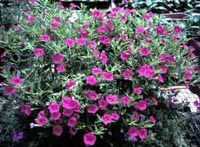Resource Library
Plant of the Week: Million Bells
The University of Arkansas System Division of Agriculture does not promote, support or recommend plants featured in "Plant of the Week." Please consult your local Extension office for plants suitable for your region.
Plant of the Week
Million Bells
Latin: Calibracoa hybrid

New plants for container gardens are the latest craze to sweep the horticultural world. We’ve seen dozens of new, interesting and beautiful flowers enter this market that growers refer to as "premium annuals."
Most of these plants have been cutting propagated, thus shortcutting the normal decade long seed development process.
One of the most charming of these new plants is a petunia look-alike called Million Bells Calibracoa. It’s such a well behaved and floriferous plant that it was selected as one of the 2001 Arkansas Select plants.
Calibracoa, pronounced kal-u-bru-koa, doesn’t really have a proper common name yet, being only introduced on grand scale in 1997. Million Bells and Lirica Showers are competing brand names, and eventually one may be chosen as a common name.
Million Bells Calibracoa is a member of the potato family and has most of the features of a petunia, except everything is shrunk down to about one-quarter scale. Flowers, available in six colors from yellow to pink and purple, have the familiar petunia look with a yellow throat and open to about the size of a quarter. They are produced in abundance throughout the season. Plants are trailing and have neat, compact foliage.
Petunias and Calibracoa were introduced into Europe from southern South America in the early 19th century along with a number of other common annual flowering plants such as scarlet sage, portulaca and the garden verbena. But petunias had larger flowers and produced more seed, so they went on to fame and glory while the small-flowered cousin slipped into the dry, dusty pages of the herbarium cabinet. Calibracoa is not mentioned in any of my references, new or old.
In 1987, a Japanese company called Suntory Ltd. developed a horticultural division and began breeding flowers. This company, little known in the West, started over a century ago as a brewer (still accounting for 50 percent of revenue) but diversified into foods, pharmaceuticals, cosmetics, publishing, resort management and flowers.
Suntory’s first big hit in the flower world was their Surfina Petunias which were propagated and released in 1989. The ever-present Wave Petunias are a seed grown version of the Surfinas. Their latest release in 1997, the genetically engineered blue flowered Moondust series carnations, have not yet made their way into the American market.
By the mid 1990's the Million Bells Calibracoa were ready for release to the world, but Suntory Ltd. did not have a marketing branch so they licensed the plant to Proven Winners Inc. This firm, a consortium of European and American firms, emerged during the decade of the 90's as a major supplier of new plants to the horticultural market. Because Calibracoa produces few seeds, the plant was initially grown in tissue culture to clean up any latent virus diseases and has since been propagated by cuttings.
Because Calibracoa is usually sold in 4-inch pots, it’s a little pricy to use as a bedding plant so it is most commonly met with in containers or hanging baskets. Its delicate flowers and trailing habit blend effectively with a host of plants in mixed containers, but for sheer blooming display, it is best shown off in hanging baskets.
It should have at least a half day of full sun, regular watering and routine fertilization to stay in bloom all summer. Unlike petunias which loaded up with seed pods and stop flowering, Calibracoa will continue blooming up to the first hard freeze.
By: Gerald Klingaman, retired
Extension Horticulturist - Ornamentals
Extension News - July 5, 2001
The University of Arkansas System Division of Agriculture does not maintain lists of retail outlets where these plants can be purchased. Please check your local nursery or other retail outlets to ask about the availability of these plants for your growing area.